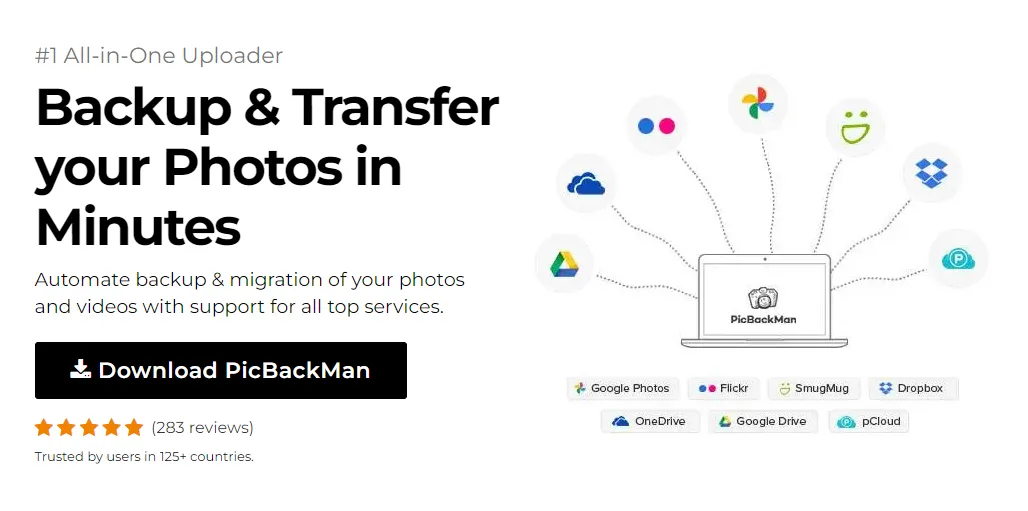
Why is it the #1 bulk uploader?
- Insanely fast!
- Maintains folder structure.
- 100% automated upload.
- Supports RAW files.
- Privacy default.
How can you get started?
Download PicBackMan and start free, then upgrade to annual or lifetime plan as per your needs. Join 100,000+ users who trust PicBackMan for keeping their precious memories safe in multiple online accounts.
“Your pictures are scattered. PicBackMan helps you bring order to your digital memories.”
How to Two-Way Sync OneDrive and Google Drive Easily


Managing files across different cloud storage platforms can be a real headache. If you use both OneDrive and Google Drive, you've probably wished for a way to keep your files in sync between these services. Good news - it's actually possible to set up a two-way sync between OneDrive and Google Drive, saving you time and preventing the frustration of managing duplicate files.
In this guide, I'll walk you through several methods to create a seamless two-way sync between these popular cloud storage services. Whether you're a student juggling school projects, a professional working across multiple platforms, or simply someone who wants more flexibility with cloud storage, this step-by-step tutorial has you covered.
Why Sync OneDrive and Google Drive?
Before diving into the how-to, let's quickly look at why you might want to sync these two services:
- Access all your files regardless of which platform you're using
- Create automatic backups across multiple cloud services
- Collaborate with team members who use different cloud platforms
- Maximize free storage space across multiple services
- Ensure your important files are never lost due to a single service outage
Method 1: Using MultCloud to Sync OneDrive and Google Drive
MultCloud is one of the most popular cloud management services that allows you to sync files between different cloud storage platforms. Here's how to use it:
Step 1: Create a MultCloud Account
- Visit the MultCloud website at www.multcloud.com
- Click on "Sign Up" to create a new account
- Enter your email address and create a password
- Verify your email address to activate your account
Step 2: Add Your Cloud Storage Accounts
- Log in to your MultCloud account
- Click on "Add Cloud" in the left sidebar
- Select OneDrive from the list of available cloud services
- Follow the prompts to authorize MultCloud to access your OneDrive account
- Repeat the process for Google Drive by clicking "Add Cloud" again
- Select Google Drive and authorize access
Step 3: Set Up Two-Way Sync
- Click on "Cloud Sync" in the top menu
- In the source section, click to select OneDrive and choose the folder you want to sync
- In the destination section, select Google Drive and choose the target folder
- Click on the "Sync Direction" dropdown and select "Two-way sync"
- Set your preferred sync options (like "Delete files in destination if they are deleted in source")
- Click "Schedule" to set up automatic syncing (hourly, daily, or weekly)
- Click "Sync Now" to start the initial sync process
MultCloud Sync Options Explained
When setting up your sync, you'll see several options that can be customized:
- Real-Time Sync: Updates files immediately when changes are detected
- Filter: Include or exclude certain file types from syncing
- Email Notification: Receive alerts when sync tasks are completed
- Conflict Resolution: Choose how to handle identical files with different versions
Method 2: Using Rclone for Two-Way Sync
Rclone is a command-line program that can sync files between multiple cloud storage services. It's free and open-source but requires some technical knowledge.
Step 1: Install Rclone
- Visit the Rclone website (rclone.org) and download the appropriate version for your operating system
- For Windows: Extract the zip file and move the rclone.exe to a permanent location
- For macOS/Linux: Open Terminal and run the installation script
- Add Rclone to your system's PATH to run it from any location
Step 2: Configure Rclone for OneDrive and Google Drive
- Open Command Prompt (Windows) or Terminal (macOS/Linux)
- Run
rclone configto start the configuration wizard - Type
nfor "New remote" - Enter a name for your OneDrive remote (e.g., "onedrive")
- Select Microsoft OneDrive from the list of storage types
- Follow the prompts to authorize Rclone to access your OneDrive
- Repeat the process for Google Drive by running
rclone configagain - Create a new remote with a name like "gdrive"
- Select Google Drive from the list of storage types
- Complete the authorization process
Step 3: Create a Two-Way Sync Script
For a two-way sync, you'll need to create a script that runs two one-way syncs:
- Create a new text file and save it with a .bat extension (Windows) or .sh (macOS/Linux)
- Add the following commands to your script:
For Windows (.bat):
@echo off rclone sync onedrive:YourFolder gdrive:YourFolder --backup-dir gdrive:backup_%date:~-4,4%%date:~-7,2%%date:~-10,2% --create-empty-src-dirs rclone sync gdrive:YourFolder onedrive:YourFolder --backup-dir onedrive:backup_%date:~-4,4%%date:~-7,2%%date:~-10,2% --create-empty-src-dirs
For macOS/Linux (.sh):
#!/bin/bash rclone sync onedrive:YourFolder gdrive:YourFolder --backup-dir gdrive:backup_$(date +%Y%m%d) --create-empty-src-dirs rclone sync gdrive:YourFolder onedrive:YourFolder --backup-dir onedrive:backup_$(date +%Y%m%d) --create-empty-src-dirs
Step 4: Automate the Sync Process
- For Windows: Set up a scheduled task using Task Scheduler
- For macOS/Linux: Create a cron job to run your script at regular intervals
Method 3: Using Insync for Desktop Integration
Insync is a paid desktop application that offers a more user-friendly approach to syncing cloud storage services.
Step 1: Download and Install Insync
- Visit the Insync website (www.insynchq.com) and download the application
- Install the application on your computer
- Launch Insync after installation
Step 2: Connect Your Cloud Accounts
- Click on the "+" button to add a new account
- Select Google Drive and log in with your Google account
- Click the "+" button again to add your OneDrive account
- Log in with your Microsoft account
Step 3: Set Up Syncing Between Services
- In the Insync dashboard, locate your Google Drive account
- Click on the folder you want to sync to OneDrive
- Click "Sync to" and select your OneDrive account
- Choose the destination folder in OneDrive
- Select "Two-way sync" from the sync options
- Click "Apply" to start syncing
Method 4: Using Cloud HQ for Automated Sync
Cloud HQ offers a specialized service for syncing between cloud storage providers with a focus on ease of use.
Step 1: Create a Cloud HQ Account
- Visit the Cloud HQ website (www.cloudhq.net)
- Click "Sign Up" to create a new account
- Enter your email address and create a password
- Verify your email address
Step 2: Connect Your Cloud Services
- Log in to your Cloud HQ account
- Click on "Sync Services" in the dashboard
- Select "Pair New Sync"
- Choose OneDrive as the first service and authorize access
- Select Google Drive as the second service and authorize access
Step 3: Configure Two-Way Sync
- Select the folders you want to sync in both OneDrive and Google Drive
- Under "Sync Direction," select "Two-way sync"
- Configure additional options like conflict resolution and file filtering
- Click "Start Sync" to begin the sync process
Method 5: Using Desktop Clients with a Common Folder
This method uses the official desktop clients for both services and a common local folder.
Step 1: Install Both Desktop Clients
- Download and install the OneDrive desktop client from Microsoft's website
- Download and install the Google Drive desktop app (formerly Backup and Sync)
- Set up both clients with your respective accounts
Step 2: Configure a Common Sync Folder
- Create a new folder on your computer (e.g., "CloudSync")
- Open OneDrive settings and click on "Choose folders"
- Make sure the common folder is selected for syncing
- Open Google Drive preferences
- Under "My Computer," add the same folder you created for OneDrive
- Ensure two-way sync is selected for this folder
Step 3: Test and Verify
- Create a test file in the common folder
- Wait for both services to sync the file
- Check both cloud services through their web interfaces to confirm the file appears in both
Comparing the Different Sync Methods
| Method | Ease of Use | Cost | Features | Best For |
|---|---|---|---|---|
| MultCloud | Easy | Free basic plan, paid premium | Scheduled sync, file filtering, multiple cloud support | General users who want a simple solution |
| Rclone | Complex | Free | Highly customizable, command-line interface, encryption | Technical users who want complete control |
| Insync | Very Easy | Paid ($29.99 one-time) | Desktop integration, offline access, selective sync | Users who prefer desktop applications |
| Cloud HQ | Easy | Free basic plan, paid premium | Automated sync, email support, conflict resolution | Business users who need reliable syncing |
| Desktop Clients | Moderate | Free | Official apps, local access to files, offline editing | Users who work primarily on one computer |
Troubleshooting Common Sync Issues
Files Not Syncing
- Check your internet connection: A stable connection is essential for syncing
- Verify permissions: Ensure the sync service has proper access to both cloud accounts
- Check file size limits: Some services have limits on file sizes that can be synced
- Look for sync conflicts: Files being edited in multiple locations can cause sync issues
Duplicate Files Appearing
- Check conflict resolution settings: Configure how the sync tool handles file conflicts
- Verify sync direction: Make sure you've set up two-way sync correctly
- Clear cache: Sometimes clearing the sync tool's cache can resolve duplication issues
Sync Speed Issues
- Check bandwidth limitations: Some sync tools allow you to limit bandwidth usage
- Reduce file quantity: Syncing thousands of small files can be slower than fewer large files
- Schedule syncs during off-hours: Set up syncs to run when you're not actively using your internet
Best Practices for Two-Way Syncing
Organizing Your Files
Before setting up your sync, organize your files effectively:
- Create a clear folder structure that works across both platforms
- Use descriptive file names that make sense regardless of platform
- Consider separating frequently and infrequently accessed files
- Keep file paths short to avoid issues with character limits
Security Considerations
When syncing between cloud services, keep these security tips in mind:
- Use strong, unique passwords for each cloud service
- Enable two-factor authentication on both OneDrive and Google Drive
- Regularly review third-party app permissions
- Consider encrypting sensitive files before syncing them
- Be cautious about syncing confidential or personal information
Backup Strategy
Even with two-way sync between cloud services, consider these backup practices:
- Create periodic local backups of your most important files
- Test your sync setup with non-critical files before committing important data
- Set up version history where possible to recover from accidental changes
- Consider a dedicated backup solution for critical files
Advanced Sync Configurations
Selective Syncing
Instead of syncing everything, you can set up selective sync for specific folders:
- Work documents might sync to both platforms
- Personal photos might stay only on Google Drive
- School projects might remain only on OneDrive
File Type Filtering
Most sync tools allow you to filter which file types get synced:
- Include only document files (.docx, .xlsx, .pdf, etc.)
- Exclude large media files (.mp4, .mov, etc.)
- Skip temporary files and system files
Scheduled Syncing
Setting up a sync schedule can help manage bandwidth and system resources:
- Hourly syncs for frequently updated work files
- Daily syncs for less critical documents
- Weekly syncs for archive folders
Quick Tip to ensure your videos never go missing
Videos are precious memories and all of us never want to lose them to hard disk crashes or missing drives. PicBackMan is the easiest and simplest way to keep your videos safely backed up in one or more online accounts.
Simply download PicBackMan (it's free!), register your account, connect to your online store and tell PicBackMan where your videos are - PicBackMan does the rest, automatically. It bulk uploads all videos and keeps looking for new ones and uploads those too. You don't have to ever touch it.
Conclusion
Setting up a two-way sync between OneDrive and Google Drive gives you the best of both worlds, allowing you to access your files across platforms while keeping everything up to date. Whether you choose a dedicated sync service like MultCloud or Cloud HQ, a technical solution like Rclone, or a desktop approach with Insync or the official clients, the methods outlined in this guide will help you create a seamless experience.
Remember to consider your specific needs when choosing a sync method. If you're not technically inclined, services like MultCloud or Insync offer user-friendly interfaces. If you want more control and don't mind using command-line tools, Rclone provides powerful customization options. Whichever method you choose, maintaining a consistent folder structure and being mindful of security will help ensure a smooth syncing experience.
With your two cloud services now working in harmony, you can enjoy increased productivity, better file organization, and the peace of mind that comes with having your important data backed up across multiple platforms.
Frequently Asked Questions
1. Will syncing between OneDrive and Google Drive use up twice the storage space?
Yes, when you sync files between OneDrive and Google Drive, the files exist in both places and count toward your storage quota on each service. This is actually an advantage if you want to maximize free storage across multiple services, but it's something to be aware of for storage management.
2. Can I sync only specific folders between OneDrive and Google Drive?
Yes, all the methods mentioned in this guide allow for selective syncing. You can choose specific folders to sync rather than your entire cloud storage. This is useful if you only want to keep certain projects or file types in sync across both platforms.
3. How often do the sync tools update files between services?
This depends on the tool you're using. Services like MultCloud and Cloud HQ offer scheduled syncs (hourly, daily, weekly) or real-time syncing with premium plans. Rclone syncs only when the script is run. Desktop client solutions typically sync shortly after file changes are detected, usually within minutes.
4. What happens if I edit the same file on both OneDrive and Google Drive before it syncs?
This creates a sync conflict. Most sync tools have conflict resolution settings that determine what happens in this scenario. Common options include keeping both versions (with one renamed), keeping the newest version, or keeping the largest version. It's best to avoid editing the same file in multiple locations before syncing.
5. Is it safe to sync sensitive or confidential files between cloud services?
While sync tools generally use secure connections, you're ultimately increasing your attack surface by storing sensitive files in multiple cloud locations. For highly sensitive data, consider encrypting the files before syncing or keeping them only in one secure location. Always review the privacy policy of any third-party sync tool you use.






